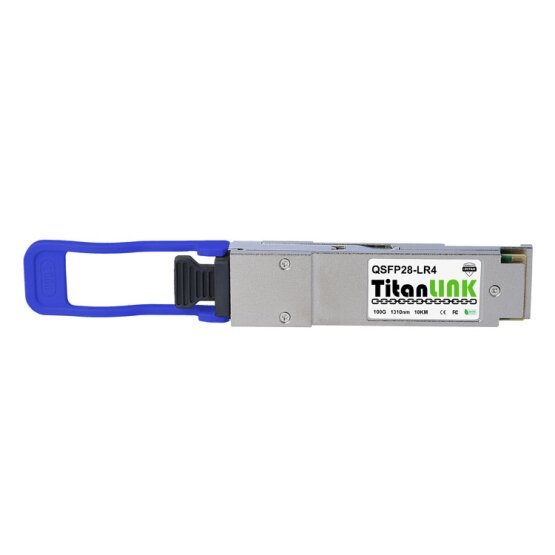The Growing Demand for Long-Haul 100G Connectivity
As data traffic in cloud services, content delivery networks, and enterprise workloads continues to surge, data centers face mounting pressure to deploy high-speed, long-haul connectivity solutions that can handle this growth efficiently. The 100G QSFP28 LR4 optical transceiver has emerged as a key enabler for extending 100Gbps connections up to 10 kilometers over single-mode fiber, making it an attractive option for large-scale data center interconnects (DCI) and leaf-spine architecture deployments. However, with higher performance often comes higher upfront investment, leading many data center operators to ask: Is the 100G QSFP28 LR4 worth it? Balancing performance, cost, and operational efficiency is crucial when considering the deployment of these modules in modern networks.
Understanding 100G QSFP28 LR4: What It Offers
The 100G QSFP28 LR4 transceiver leverages four lanes of 25Gbps, multiplexing them over coarse wavelength-division multiplexing (CWDM) on single-mode fiber to deliver an aggregate 100Gbps data rate over distances of up to 10km. This makes it particularly useful for interconnecting racks in large-scale campuses, connecting data centers within a metropolitan area, or bridging long distances between core network nodes without requiring complex amplification systems. Using a duplex LC interface simplifies cable management, while the QSFP28 form factor ensures compatibility with modern high-density switches. Compared to multimode SR4 transceivers, which are limited to 70-100 meters, LR4 modules provide the flexibility and reach necessary for scalable, high-speed deployments across campus and metro environments.
Performance Advantages in Long-Haul Data Center Interconnects
One of the core reasons why data centers consider 100G QSFP28 LR4 modules is the ability to maintain high bandwidth over extended distances with low latency, supporting latency-sensitive applications such as financial trading, AI workloads, and large-scale data analytics. In leaf-spine architectures, LR4 transceivers facilitate direct connections between spine switches across multiple rows or buildings, reducing the need for additional network hops that can add latency and complexity. Moreover, the use of single-mode fiber ensures lower attenuation and dispersion over longer distances, maintaining signal integrity and ensuring stable 100Gbps performance without costly regeneration equipment.
Evaluating the Cost Considerations
While the performance benefits of 100G QSFP28 LR4 are clear, cost remains a significant factor in deployment decisions. LR4 modules are generally more expensive than their SR4 multimode counterparts due to the use of CWDM optics and the precision required in their design for long-haul transmission. Additionally, single-mode fiber cabling costs more per meter than multimode fiber; however, it offers greater scalability for future bandwidth upgrades and longer reach without needing additional cabling infrastructure. For data centers planning to deploy high-speed connections over several kilometers, the cost per bit over the operational lifespan often favors LR4, as the initial investment can be offset by reduced network complexity, lower maintenance costs, and the elimination of intermediate equipment.
Power Consumption and Operational Efficiency
Another aspect to consider is power consumption, as higher-speed transceivers typically consume more power than lower-speed options. However, compared to legacy 100G CFP or CFP2 modules, QSFP28 LR4 offers a compact, lower-power solution while delivering the same bandwidth. Modern LR4 modules typically operate at power consumption levels of around 3.5-4.5W, which is efficient for 100G long-haul connectivity. Lower power consumption not only reduces operational costs but also minimizes heat output within switch environments, improving the overall energy efficiency and thermal management in high-density data center deployments.
Scalability and Future-Proofing Your Network
Deploying 100G QSFP28 LR4 modules can be seen as a step toward future-proofing your data center network infrastructure. As data volumes continue to rise with the growth of cloud computing, AI workloads, and IoT devices, the demand for high-speed interconnects will only increase. By investing in LR4-based connectivity, data centers can build a scalable foundation capable of handling bandwidth-intensive workloads while maintaining low latency and high reliability across extended distances. Additionally, the infrastructure used for LR4 deployments, including single-mode fiber, aligns with future migration paths to 200G and 400G, allowing for smoother upgrades without significant changes to the cabling infrastructure.
Balancing Performance and Cost: Is 100G QSFP28 LR4 Worth It?
Determining whether 100G QSFP28 LR4 is worth the investment depends on your data center’s size, layout, and long-term connectivity needs. For large-scale data centers requiring 100G connectivity beyond 100 meters, LR4 becomes the practical and often the only viable choice without resorting to complex and expensive alternatives like active optical cables or intermediate switching. While the initial investment may be higher, the long-term operational efficiencies, reduced network complexity, and performance benefits can translate into a lower total cost of ownership over the lifespan of the deployment. Furthermore, as LR4 modules become increasingly common, market competition has led to declining prices, making them more accessible for mid-sized enterprises seeking to modernize their network backbones.
Conclusion
In conclusion, the 100G QSFP28 LR4 optical transceiver offers a compelling balance of high performance and operational efficiency for long-haul data center connectivity. Its ability to deliver stable 100Gbps over 10km, paired with low latency and high reliability, supports the growing demand for high-speed connections across large data center campuses and metropolitan networks. While requiring a higher upfront investment, its long-term benefits in scalability, network simplicity, and operational cost efficiency make it a worthwhile investment for data centers aiming to build a future-ready, high-performance network infrastructure. As your data center expands to meet the increasing demands of cloud, AI, and big data, 100G QSFP28 LR4 can serve as a cornerstone of your high-speed connectivity strategy, ensuring that your infrastructure remains competitive in the rapidly evolving digital landscape.


